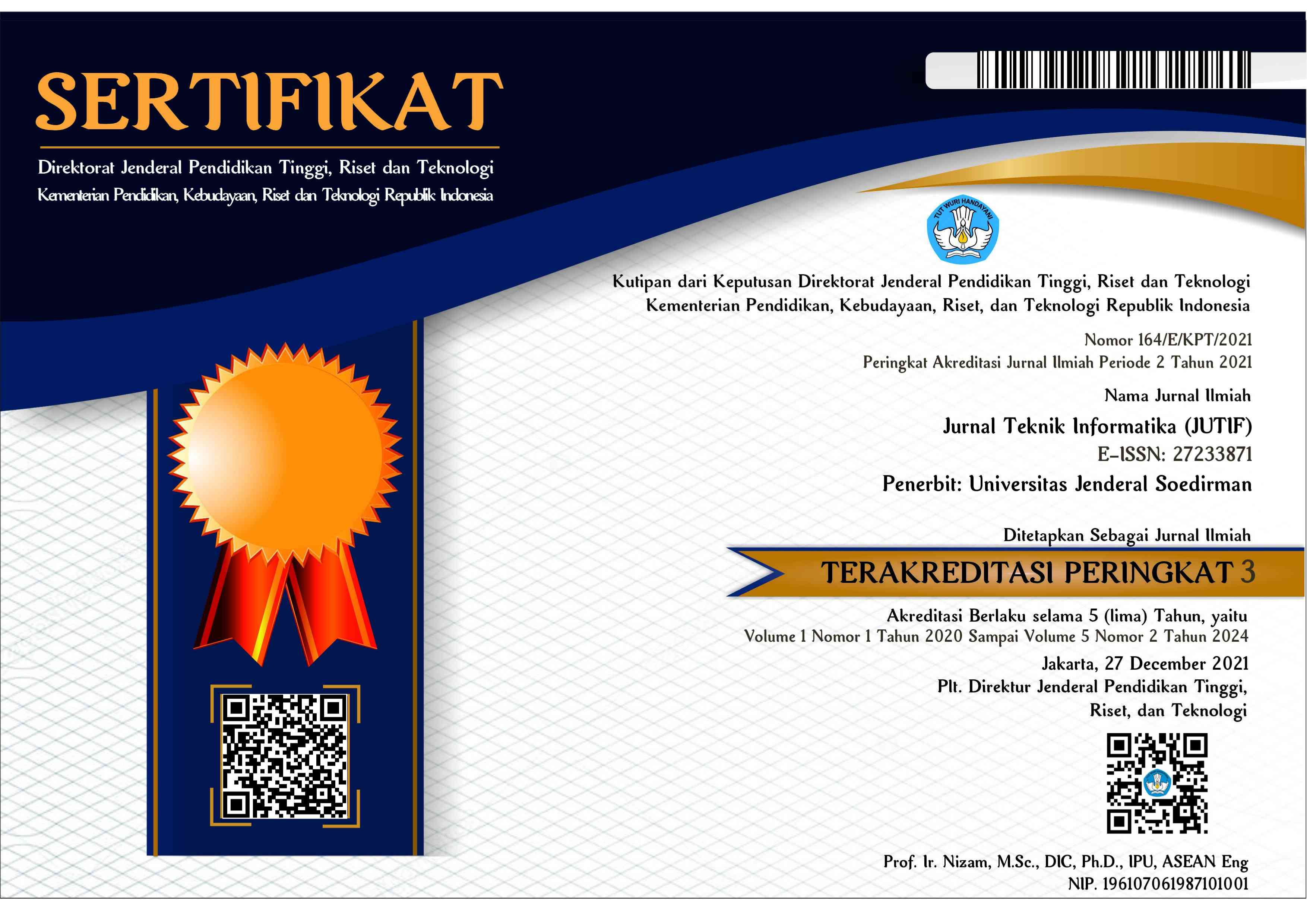STREAM CIPHER ALGORITHM FOR ENCRYPTING TEXT USING LOGISTIC MAP, AUTO PARAMETERS LINEAR CONGRUENTIAL GENERATOR (APLCG), AND GRAY CODE
Abstract
One aspect frequently posing a challenge in cryptography pertains to the length of the secret key that users must remember. Achieving the requisite key length for cryptographic algorithms necessitates key padding. However, it is crucial to note that key padding is susceptible to predictable patterns. Both the Linear Congruential Generator (LCG) and gray code are algorithms employed to generate sequences of padded key bits. Regrettably, LCG requires the determination of two pre-defined parameters, whereas the Auto Parameters Linear Congruential Generator (APLCG) automatically establishes these parameters. These parameters play a pivotal role in generating unique sequences of random integers. To fortify key security, the generation of new keys is performed using a modified logistic map, an enhancement of the standard logistic map that exhibits random behavior consistently. Stream cipher, an encryption algorithm, necessitates a continuous key stream matching the bit or byte length of the message. We conducted experiments on stream cipher algorithms employing key streams generated from APLCG, gray code, and modified logistic map. Twenty text documents were utilized as test samples. The outcomes indicate that stream ciphers employing APLCG, gray code, and modified logistic map demonstrate high-security performance based on the statistical analysis conducted.
Downloads
References
B. F. Vajargah and R. Asghari, “Cryptographic Secure Pseudo-random Generation : The Chaotic Linear Congruential Generator (CLCG),” Sci. Int., vol. 27, no. 3, pp. 1797–1801, 2015, [Online]. Available: http://www.sci-int.com/pdf/659911501 a 1797-1801 Meisam Asghari--MATH--IRAN--COMPOSED.pdf
L. Diedrich, L. Murati, and A. Wiesmaier, “Stream ciphers in the IoT: Grain and Trivium,” pp. 1–19, 2015, [Online]. Available: http://download.hrz.tu-darmstadt.de/media/FB20/Dekanat/Publikationen/CDC/GrainAndTrivium.pdf
M. Yusuf, A. Arizal, and I. R. Hikmah, “Implementation Cryptography and Access Control on IoT-Based Warehouse Inventory Management System,” Matrik J. Manajemen, Tek. Inform. dan Rekayasa Komput., vol. 22, no. 1, pp. 37–50, 2022, doi: 10.30812/matrik.v22i1.1849.
N. Balaska, Z. Ahmida, A. Belmeguenai, and S. Boumerdassi, “Image encryption using a combination of Grain‐128a algorithm and Zaslavsky chaotic map,” IET Image Process., vol. 14, no. 6, pp. 1120–1131, May 2020, doi: 10.1049/iet-ipr.2019.0671.
M. Alawida, A. Samsudin, N. Alajarmeh, J. Sen Teh, M. Ahmad, and W. H. Alshoura, “A Novel Hash Function Based on a Chaotic Sponge and DNA Sequence,” IEEE Access, vol. 9, pp. 17882–17897, 2021, doi: 10.1109/ACCESS.2021.3049881.
E. Abass Albhrany, L. Fayeq Jalil, and H. Hadi Saleh, “New Text Encryption Algorithm Based on Block Cipher and Chaotic Maps,” vol. 2, no. 2, pp. 67–73, 2016.
J. Machicao, M. Alves, M. S. Baptista, and O. M. Bruno, “Exploiting ergodicity of the logistic map using deep-zoom to improve security of chaos-based cryptosystems,” Int. J. Mod. Phys. C, vol. 30, no. 05, p. 1950033, May 2019, doi: 10.1142/S0129183119500335.
M. Elveny, R. Syah, I. Jaya, and I. Affandi, “Implementation of Linear Congruential Generator (LCG) Algorithm, Most Significant Bit (MSB) and Fibonacci Code in Compression and Security Messages Using Images,” J. Phys. Conf. Ser., vol. 1566, no. 1, p. 012015, Jun. 2020, doi: 10.1088/1742-6596/1566/1/012015.
C. Han, “An image encryption algorithm based on modified logistic chaotic map,” Optik (Stuttg)., vol. 181, pp. 779–785, Mar. 2019, doi: 10.1016/j.ijleo.2018.12.178.
H. Ogras and M. Turk, “An efficient method to improve the Logistic map: Design and implementation,” in 2016 Third International Conference on Electrical, Electronics, Computer Engineering and their Applications (EECEA), Beirut, Lebanon: IEEE, Apr. 2016, pp. 24–28. doi: 10.1109/EECEA.2016.7470760.
M. Alawida, “A novel chaos-based permutation for image encryption,” J. King Saud Univ. - Comput. Inf. Sci., vol. 35, no. 6, p. 101595, Jun. 2023, doi: 10.1016/j.jksuci.2023.101595.
M. Alawida, J. Sen Teh, A. Mehmood, A. Shoufan, and W. H. Alshoura, “A chaos-based block cipher based on an enhanced logistic map and simultaneous confusion-diffusion operations,” J. King Saud Univ. - Comput. Inf. Sci., vol. 34, no. 10, pp. 8136–8151, Nov. 2022, doi: 10.1016/j.jksuci.2022.07.025.
R. S. Bhogal, B. Li, A. Gale, and Y. Chen, “Medical Image Encryption using Chaotic Map Improved Advanced Encryption Standard,” Int. J. Inf. Technol. Comput. Sci., vol. 10, no. 8, pp. 1–10, Aug. 2018, doi: 10.5815/ijitcs.2018.08.01.
B. Krishnaveni and S. Sridhar, “Role of Distance Measures in Approximate String Matching Algorithms for Face Recognition System,” in IFIP Advances in Information and Communication Technology, vol. 578, 2020, pp. 157–169. doi: 10.1007/978-3-030-63467-4_12.
X. Zhang, L. Wang, G. Cui, and Y. Niu, “Entropy-Based Block Scrambling Image Encryption Using DES Structure and Chaotic Systems,” Int. J. Opt., vol. 2019, pp. 1–13, Aug. 2019, doi: 10.1155/2019/3594534.
H. Wen et al., “Design and Embedded Implementation of Secure Image Encryption Scheme Using DWT and 2D-LASM,” Entropy, vol. 24, no. 10, p. 1332, Sep. 2022, doi: 10.3390/e24101332.
G. Alvarez, D. Arroyo, and J. Nunez, “Application of gray code to the cryptanalysis of chaotic cryptosystems,” 3rd Int. IEEE Sci. …, 2007, [Online]. Available: http://www.researchgate.net/publication/215732242_Application_of_Gray_code_to_the_cryptanalysis_of_chaotic_cryptosystems/file/79e415057608d30b9d.pdf
Anonymous, “English Fairy Tales.” Accessed: Oct. 05, 2023. [Online]. Available: https://www.gutenberg.org/files/7439/7439-0.txt
A. F. Shimal, B. H. Helal, and A. T. Hashim, “Extended of TEA: A 256 bits block cipher algorithm for image encryption,” Int. J. Electr. Comput. Eng., vol. 11, no. 5, p. 3996, Oct. 2021, doi: 10.11591/ijece.v11i5.pp3996-4007.
Permana langgeng wicaksono ellwid putra, C. A. Sari, and F. O. Isinkaye, “Secure Text Encryption for IoT Communication Using Affine Cipher and Diffie-Hellman Key Distribution on Arduino ATMEGA2560 IoT Devices,” J. Tek. Inform., vol. 4, no. 4, pp. 849–855, Aug. 2023, doi: 10.52436/1.jutif.2023.4.4.1129.
Copyright (c) 2024 Adriana Fanggidae, Yulianto Triwahyuadi Polly, Derwin Rony Sina, Kornelis Letelay, Yelly Yosiana Nabuasa, Meiton Boru, Juan Rizky Mannuel Ledoh

This work is licensed under a Creative Commons Attribution 4.0 International License.




























